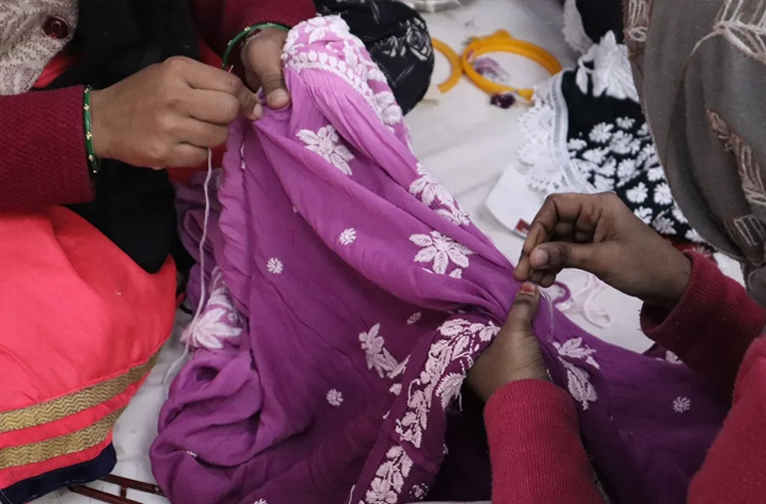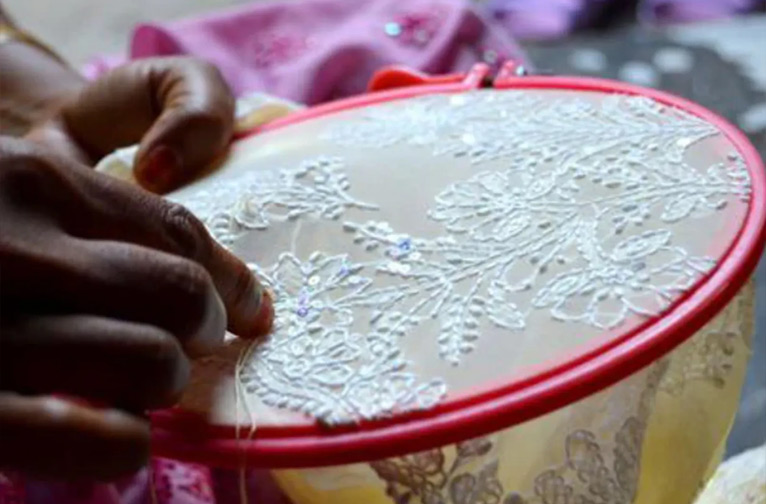Intertwined with the beautiful Indian textile tradition of chikankari, is its deep connection with the Nawabs of Awadh in the 18th and 19th centuries. Not many people are privy to the fact that it was Nawab Asif-Ud-Daula (1775-1789) and Nawab Wajid Ali Shah (1851-1856) who played a pivotal role in the protection and promotion of this floral hand embroidery heritage. This exquisite tradition is based on the finest of gossamer muslins and silks and has an even deeper history in India.
Legend has it that Noor Jehan, the powerful wife of the Mughal Emperor Jehangir first introduced this Persian tradition in India. Daughter to the Persian aristocrat Mirza Ghiyas Beg and his wife Asmat Begum, Noor Jehan was renowned as much for her aesthetic sense as she was for the power she wielded behind the throne.
There’s an even earlier link to this white-on-white embroidery which surfaces from around the time of the famous king Harsha (590-647 CE). An even earlier record from an account from the 3rd century BC by Megasthanes, the Greek ambassador of Seleucus I Nicator to the Emperor Chandragupta Maurya, who mentions the popularity of “flowered muslin” amongst his courtiers.
Fairytale Fabric
The simple act of piercing gossamer fine fabric with needle and thread by the hands of an artisanal craftsman has scripted a beautiful narrative of magic and artful splendour.
'Chikankari' is rooted in the Persian word 'chikin/ chikeen’, which means any kind of embroidered flower. Originally intricately rendered as ‘white on white’, or white thread embroidery on white muslin cloth, chikan work found its voice in the tight-fitting pajama or shalwar, the bodice (choli), peshwaz a loose jama-like robe that fastened by ties at the waist, elaborate lehengas and odhinis for the ladies. The gossamer fine muslin that the begums of the Mughal harem wore went by romantic names such as Ab-i-Rawan (running water), Shabnam (night dew) and Daft Hawa (woven air).
For the men there were garments such as the ankle length peshwaz, somewhat like the jamah (coat) but usually transparent, angarkhas, tunics, achkans, the qaba, a cotton made tunic, mostly of fine muslin was worn in summer, small caps (topis) and cummerbands.
Eco-Friendly Processes
Chikankari production is even more relevant in these contemporary times as it has a lower carbon footprint. The process involves several steps including designing, engraving, block printing, embroidery, washing and finishing.
The Creative Technique
Today, though cotton remains a popular choice, chikankari is also carried out on mulls/malmal, muslins, voiles and organzas.
Highly labour intensive chikankari has been raised to an art form by skilled hands which have an intimate connection with embroidering floral motifs and patterns on gossamer-thin muslin or other lightweight fabrics.
Five basic steps are involved in the craft:
Design: The overall look of the embroidery is defined on paper.
Engraving: The design is engraved on wooden blocks later transferred on to the fabric to be embroidered
Block Printing: The embroidery design finds its place on the fabric with the help of block printing with a washable ink (neel/ Indigo or safeda dye).
Embroidery: The embroidery is carried out with a fine chikan needle. Chikankari embroidery has 32 stitches which may be used individually or in combined form. The 6 basic stitches of chikankari include Tepchi (back running stitch), Bakhiya (double backstitch), Hool (eyelet), Zanzeera (chain stitch), Rahket (stem stitch) and Banarasi. Stitches fall in two categories— a flat surface using a single thread and the other, using up to 12 threads to create an embossed effect.
Embroidery designs in chikankari work are largely nature-inspired thus featuring motifs such as flowers, birds, and leaves, and vines. Popular patterns in chikankari work include florals, paisley, buta work, full Jaal and half jaal.
Washing and Finishing: With the completion of the embroidery the fabric is carefully washed properly to remove any traces of the design print. This is followed by starching the fabric to give it a crisp and elegant finish.
A Sustainable Choice
At the heart of the origins of chikankari is the eco-friendly production process supported ably by the reliance on organic fabrics, natural dyes and hand-crafted embroidery.
Its sustainable, ethical, and timeless spirit serves as the perfect fit for the eco-conscious buyer. Supporting this beautiful fashion tradition also means ‘doing good’ to the small, community-based workshops and their craftsmen who toil over each piece with their ancestral skills.
A Revival Scripted By SEWA
The Raj-era is well noted for creating a huge crisis for India’s textile industry, given the heightened greed for quick profits with machine-made alternatives. Chikankari was amongst those handcrafted traditions to bear the brunt of this with the rising import of machine-made textiles. What further heightened the plight of the craft was the ending of the patronage of the erstwhile Nawabs and zamindars (landowners). Sadly, this dying royal tradition was relegated to a low standard ill-paid commercial activity, involving mostly women alone, unlike the days when the Master craftsmen were all men. Manufacturers used middlemen to exploit women artisans who were not only very poor but also women cloistered and in purdah.
The wrenching back of chikankari from the abyss of extinction is a remarkable story. This highly acclaimed craft fell to abysmal depths once the patronage of the erstwhile Nawabs and landowners ended. The Lucknow-based NGO Sewa (Self-Employed Women’s Association) has played a pivotal role in reviving the fortunes of underprivileged women. Set up in 1984 with just 31 women, NGO Sewa set in motion this game-changing journey for its members by doing away with the middleman and the organization to act as a platform from where the artisans would address the market directly for the work they rendered.
Helming the revival of chikankari with the help of these ladies, social worker Ruma Banerjee worked tirelessly to ensure that the artisans would also benefit from these laborious handcrafting traditions. Today over 7000 women at SEWA are keeping the flag flying in protecting this beautiful textile tradition which has made a mark with its footprint in markets both in India and abroad.
In the year 2008, chikankari was bestowed the coveted the Geographical Indication (GI) tag.
Shopping for chikankari
While the earlier tradition of white on white is well embedded in chikankari work, it is now also found on coloured fabrics and coloured threads are also being used.
What’s also lovely is that the craftsmen have expanded their skills across a wide canvas, which includes not only kurta-pyjama sets and sarees but also dupattas, pillow slips, table linen, curtains and bed covers etc. While SEWA has long held a rock-solid position in the market for its quality and beautiful range, there are other brands now also readily available in the shops around Chowk Bazaar or the Gol Darwaza Lane at Chowk Crossing.
That one may choose from several good brands in the market is very good to keep this craft alive. You should suss out the local karigars who spend hours bent over their work creating each artful piece with incredible patience, unmindful of the hustle and bustle of the bazaar around them.
Distinguishing the hand embroidered chikankari work from today’s machine-made spin-offs is no rocket science. You just need to keep several things in mind while making your purchases. The 'real' things will obviously be more expensive given the labour that goes into making each piece. But there are scam artists who can palm off a machine-made item for the same price to the novice buyer. Nothing like actually touching the item to ensure that it’s the real thing.


The human hand marks its presence on real chikankari through tiny natural irregularities and asymmetries, whereas a machine-made effect is evident through the look of perfection of the carbon-copy stamp of each motif. The fabric is much lighter and more malleable when it is authentic muslin or silk. Also, you’ll find that machine-made embroidery depends on heavier, less fine fabric. On a machine-made item, the embroidery feels smoother and more flat, unlike in the handmade piece where the stitches appear to be slightly raised to the touch.
Take home a slice of Lucknavi heritage in the form of the most exquisite renditions of chikankari works available for women, men and children, while lending your support to the artisans who protect this exquisite heritage in India’s textile traditions